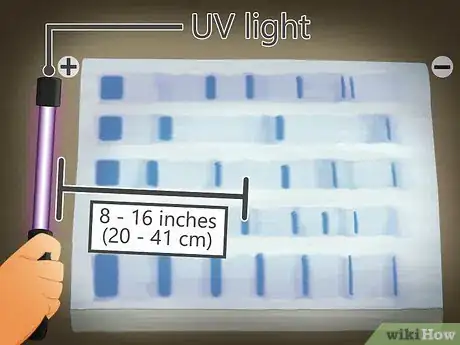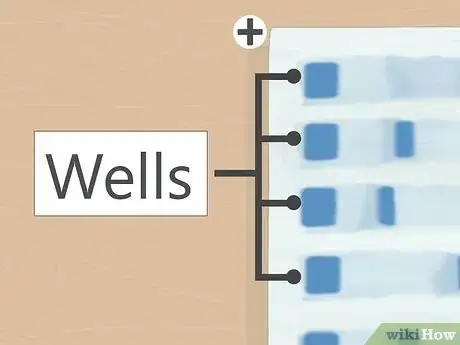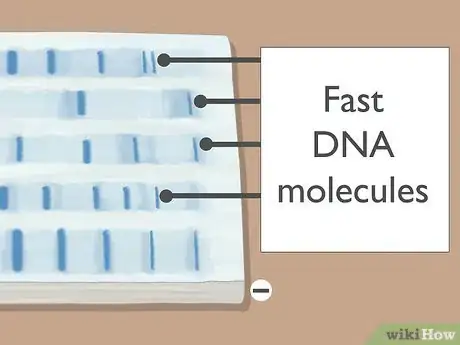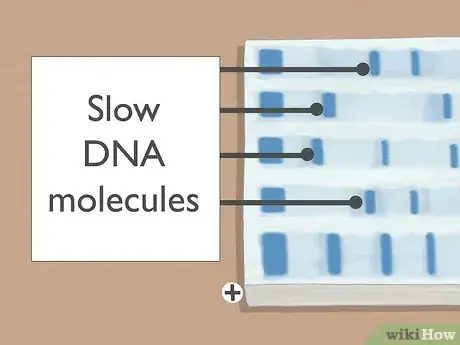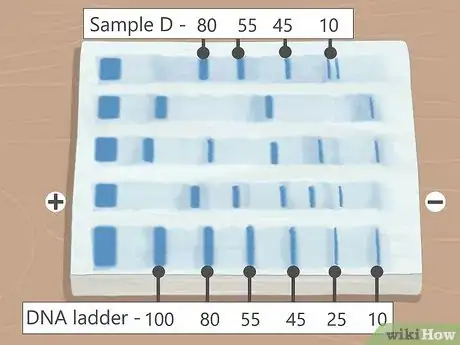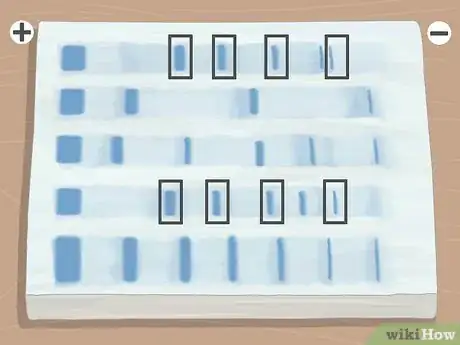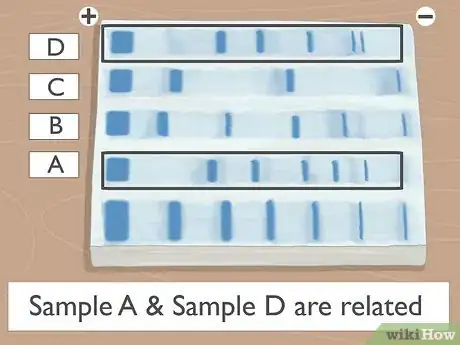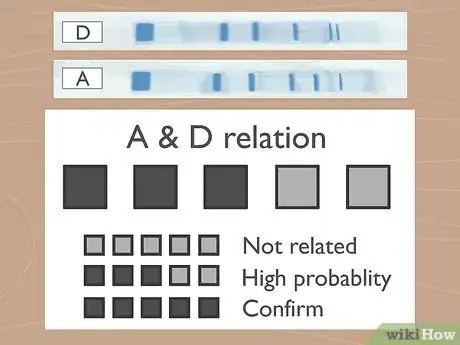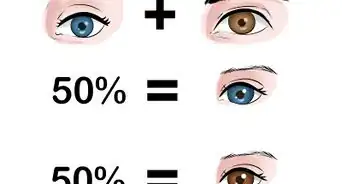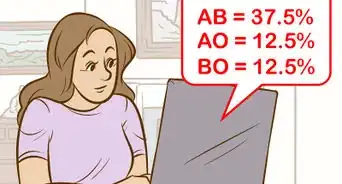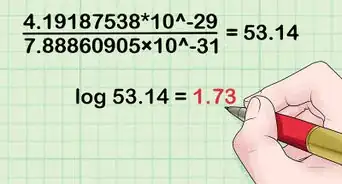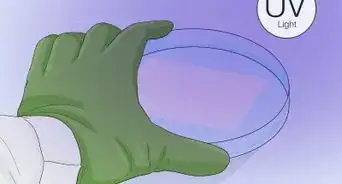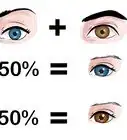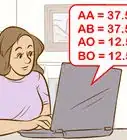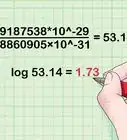This article was co-authored by wikiHow staff writer, Eric McClure. Eric McClure is an editing fellow at wikiHow where he has been editing, researching, and creating content since 2019. A former educator and poet, his work has appeared in Carcinogenic Poetry, Shot Glass Journal, Prairie Margins, and The Rusty Nail. His digital chapbook, The Internet, was also published in TL;DR Magazine. He was the winner of the Paul Carroll award for outstanding achievement in creative writing in 2014, and he was a featured reader at the Poetry Foundation’s Open Door Reading Series in 2015. Eric holds a BA in English from the University of Illinois at Chicago, and an MEd in secondary education from DePaul University.
There are 10 references cited in this article, which can be found at the bottom of the page.
This article has been viewed 21,229 times.
Learn more...
Gel electrophoresis is a type of biotechnology that separates molecules based on their size to interpret an organism’s DNA. An enzyme is used to separate a strand of DNA from a source and the DNA is suspended in a dye. Then, the dye is applied to a negatively-charged gel on one side of a sheet. The DNA automatically travels through a set of horizontal stripes on the sheet to reach the positively-charged gel on the other side. Gel electrophoresis is helpful when determining relatedness between two or more species or individual specimens. It also can help provide establish a DNA fingerprint.
Steps
Viewing Samples
-
1Hold a UV light up to the gel sheet to reveal results when using a UV-based dye. With your gel sheet in front of you, find the switch on a tube of UV light to turn it on. Hold the UV light 8–16 inches (20–41 cm) away from the gel sheet. Illuminate the DNA samples with the UV light to activate the dye and read the results. If the test was performed properly, your sheet should have 2-8 sets of vertical stripes in parallel rows.[1]
- If you’re reading results that have been printed on a sheet of paper, you can skip this step.
- Not all stains require UV-light for visualisation. Check which stain you used and how to properly visualise it (for example, some dyes may be activated by blue light, or are readily visible without need for any special lights).
Warning: Wear gloves and protective eyewear when physically handling a gel sample. Touching the gel can interfere with your results and some of the gels and dyes are harmful if they get in your eyes. UV light is also damaging to living tissues. Place the gel sheet on a piece of wax paper if you’re removing it from the machine.
-
2Find the wells by looking for the biggest pools of color. To properly orient yourself, you need to find the original location of the samples, called the wells. With your sheet in front of you, look for the end of the sheet with a big pool of colored gel. The wells are the locations where the gel samples are loaded into the sheet and indicate the start of the sample.[2]
- There should be one well for each of your samples. If one of the wells is lacking color, the sample may have been applied poorly.
- The wells indicate the negative end of the sheet. The opposite side of the sheet is the positive end. When each sample is applied to the sheet, the negatively-charged DNA travels across the sheet to the positive pole.
Advertisement -
3Classify each strip by noting the origin of the samples. If you’ve been given a key, understand that each horizontal row depicts a unique set of DNA. Use your key to determine what each row represents. The number of samples can be determined by counting the number of rows. If you haven’t been given a key, you cannot determine the source of each sample. Electrophoresis only provides you with information about a DNA sample’s behavior, but it doesn’t reveal the source of a sample on its own.[3]
- If you performed the test yourself, write down where each row’s sample is from while you’re applying the gel.
-
4Identify the DNA ladder to establish a scale for the DNA. Depending on whether or not a DNA ladder was included in the test, you may have one strip designed to provide you with a scale to make comparisons easier. This scale is called the DNA ladder. The DNA ladder will contain strips of DNA of known sizes to make it easier to figure out how big or small the other strips are.[4]
- Actual DNA samples will have a lot of variation in the sequence of the strips. There may be a few thin strips, followed by 1–2 inches (2.5–5.1 cm) of empty space, followed by thick strips, and ending in more thin strips. The DNA ladder will make it easier to figure out how big the individual strips actually are by giving you something to compare them to.
- The DNA ladder is almost always placed in the last row at the top or bottom of your sheet.
Assessing Sample Size
-
1Identify strips further from the wells to find the smaller DNA molecules. When each sample is applied, it starts moving away from the negative pole towards the positive pole, because DNA is negatively charged due to the phosphate groups in its backbone. However, this is not what causes the molecules to separate based on size. Larger DNA molecules are slower because they have more mass to be moved, but they also experience a higher force from the electric field because they have more negatively charged phosphate groups. These two cancel each other out exactly. What does cause the separation, is the resistance that the sample molecules experience from the gel. Smaller molecules can more easily migrate through the pores of the gel, so when the gel electrophoresis is stopped, they will have travelled further.[5]
-
2Find the strips closest to the wells to find the slower DNA. Completely analogous to the previous step, large molecules will migrate more slowly through the pores of the gel, so when the electrophoresis is stopped, they won't have travelled as far as a shorter molecule. Looking at the frequency of the bigger and smaller strips as they appear in a single row you a good picture of the sample’s DNA fingerprint.[6]
- The way individual strips are arranged in a sequence is unique to each genetic sample. The pattern of strips creates a specific picture of someone’s genetic makeup.
- The thickness of each band is not an indication of how long the DNA molecules are, but of how many there are.
-
3Use the DNA ladder to determine the size of each strip. The DNA ladder is used to give you a scale to compare the individual strips to. The size of the strips in a DNA ladder depend upon the type of ladder that was used for the test, but it will typically be either 10-100 bp (base pairs), or 500-1000 bp. The strip closest to the wells is the highest size in a spectrum and the one furthest from the wells is the lowest. So for a 10-100 bp ladder, the one closest to the wells is 100 bp, and the one furthest is 10 bp.[7]
- 1000 bp is the same as 1 kb. Kb is short for kilobase, and the ladder may use this unit instead of bp. The smaller the scale is, the more accurate the comparisons will be.
- Base pairs and kilobases are simply units of measurement. They refer to the physical size of a DNA molecule.
Tip: The range of a DNA ladder is printed on the bottle that the ladder came in. It may also be listed on the key if you were given one. There is no way to determine the range of a ladder based on the strip alone, since different gels will allow samples to travel at different speeds.
Making Conclusions
-
1Look for strips that appear at the same point on the sheet to find similarities. When looking at the sheet holistically, look for points where 2 or more strips appear in identical locations on different rows. This is an indicator that the DNA samples are somehow related. If there are 2 or more rows without any overlap in the sequence, they are entirely unrelated. The more related 2 samples are, the more overlap there will be in their sequences.[8]
- In other words, if you’re looking at the sheet with the wells on the left, you’re looking for vertical columns where 2 strips appear at the same time.
- For example, a mother and her child will have half of their strips overlapping. A child and their second cousins though may only have 2-3 strips that overlap.
-
2Identify identical samples by finding strips with the same configuration. If 2 or more samples have a nearly identical sequence of strips, they’re the same DNA. This doesn’t necessarily mean that the source of the sample is the same—identical twins, for example, will have the same DNA sequence on an electrophoresis sheet. Identical strips are usually required to reasonably tie a suspect to a crime scene.[9]
Tip: Electrophoresis is often used by forensics teams to rule out suspects in criminal cases. It is also used to test maternity or paternity.
-
3Understand the limitations of electrophoresis testing. Electrophoresis testing is helpful when it comes to comparing DNA samples, but it can be hard to make definitive conclusions sometimes. The scale can only get so magnified, and smearing can make bands hard to interpret. In some instances, you won’t be able to conclusively say that 2 samples are related.[10]
- More than 2 overlapping bands indicates a strong similarity between 2 samples. When assessing results, scientists will often say that there is a “high probability” that 2 samples are related if less than half of the bands in 2 samples overlap.
Warnings
- If you’re performing the gel electrophoresis yourself, take proper safety precautions when working with hazardous materials. Some gels contain toxic ingredients. Wear a dust mask and rubber gloves when working with hazardous chemicals.[11]⧼thumbs_response⧽
References
- ↑ https://sciencing.com/read-gel-electrophoresis-5398589.html
- ↑ https://learn.genetics.utah.edu/content/labs/gel/electrophoresis/
- ↑ https://learn.genetics.utah.edu/content/labs/gel/electrophoresis/
- ↑ https://youtu.be/ZDZUAleWX78?t=366
- ↑ https://www.khanacademy.org/science/ap-biology/gene-expression-and-regulation/biotechnology/a/gel-electrophoresis
- ↑ https://cdn.vanderbilt.edu/vu-wp0/wp-content/uploads/sites/267/2021/06/02163125/Lab4_Electrophoresis_MiniOne_June20212.pdf
- ↑ https://www.hindawi.com/journals/jna/2012/254630/
- ↑ https://www.ncbi.nlm.nih.gov/pmc/articles/PMC4846332/
- ↑ https://bio.libretexts.org/Courses/Harrisburg_Area_Community_College/Biol_101%3A_General_Biology_l_-_Laboratory_Manual/01%3A_Labs/1.11%3A_Gel_electrophoresis
